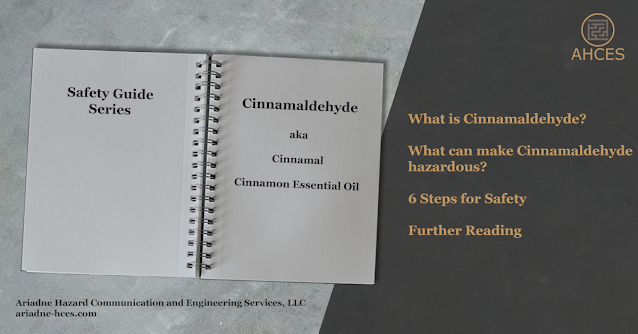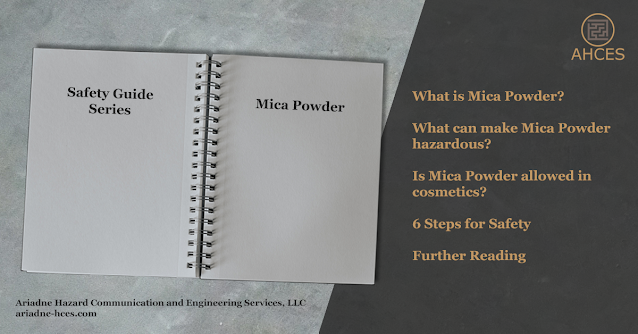Cinnamaldehyde Safety Guide
What is Cinnamaldehyde?
Cinnamaldehyde, also known as cinnamal or cinnamon essential oil, is a naturally occurring organic compound produced by trees of the Cinnamomum genus. It is the primary compound that gives the spice cinnamon its distinctive flavor. While it is possible to create synthetic cinnamaldehyde, most is extracted by steam distillation from natural sources.
Cinnamaldehyde has the CAS Number 14371-10-9.
The CAS Number is used to identify cinnamaldehyde on documents including safety data sheets and chemical labels. When looking for cinnamaldehyde in a product, check for the CAS number on the associated safety documents.
Notable Properties of Cinnamaldehyde
Cinnamaldehyde is a liquid at room temperature, with a pale yellow to yellow-green color. It smells distinctly and strongly of cinnamon. Natural cinnamaldehyde, or cinnamon essential oil, often contains other compounds which can change some chances to the coloration or scent compared to synthetic, pure cinnamaldehyde.
What Makes Cinnamaldehyde Hazardous?
Cinnamaldehyde is an irritant. It can cause skin, eye, and respiratory irritation.
Cinnamaldehyde can cause allergic reactions in those allergic to cinnamon. It is also known to be a sensitizer, resulting in the development of an allergic reaction after repeated exposures.
Cinnamaldehyde Frequently Asked Questions
Is Cinnamaldehyde Flammable?
Pure cinnamaldehyde is an organic compound and can burn. It is not considered flammable for the purposes of workplace or transportation safety.
Cinnamaldehyde that was extracted through the use of ethanol can be flammable. This is due to the fact that ethanol is flammable.
Be sure to check the safety documents of the individual cinnamaldehyde product being used, as the chemical label and safety data sheet will both indicate if the product is considered flammable.
Is Cinnamaldehyde Toxic?
Cinnamaldehyde is not considered toxic. Some studies have shown that if undiluted cinnamaldehyde is ingested, irritation to the gastrointestinal system can occur.
The primary human health concern with cinnamaldehyde is skin irritation and sensitization, causing skin allergies.
Does Cinnamaldehyde Kill Bacteria? Does Cinnamaldehyde Have Antibacterial Properties?
There has been scientific study on the antibacterial properties of cinnamon, with positive observations on cinnamon extracts and cinnamon essential oil inhibiting bacterial growth.
However, as cinnamaldehyde is a skin irritant and sensitizer, it is not suitable for topical use as a hand sanitizer.
6 Steps for Safety
Step 1: Read the Warnings
When working with a product for the first time, always read all the safety documents first. This includes safety data sheets, which should be provided by the manufacturer or importer of the cinnamaldehyde product. There may also be an OSHA chemical label or a Consumer Protection label on the packaging of the cinnamaldehyde product. These documents all contain important information on the hazards of the product and instructions on how to mitigate those hazards.
Note that different cinnamaldehyde products can have different safety considerations depending on the other ingredients. Pure, steam-distilled cinnamaldehyde will only have the safety hazards of being an irritant and sensitizer. Cinnamon essential oil extracted with ethanol will also be flammable. Be sure to check the specific safety hazards of individual products.
Step 2: Prepare Your Workspace
Creating a safe workspace, sometimes referred to as engineering control, is a key component of working safely with any potentially hazardous substance.
Cinnamaldehyde is a liquid in its pure form, which means it can easily flow when spilled, as well as seep into surfaces. Therefore, it is important to have a spill kit available with absorbent material to soak up and capture any spilled cinnamaldehyde.
If the cinnamaldehyde solution also contains ethanol, or another flammable substance, it is also important to have a fire extinguisher on hand.
Step 3: Gather Your PPE
For working with cinnamaldehyde, you will need the
following PPE.
- Gloves
- Basic disposable gloves, or other rubberized gloves, will prevent cinnamaldehyde from touching the skin on the hands and causing irritation.
- Rubberized Apron
- A rubberized apron, or another body covering that prevents cinnamaldehyde from soaking into clothing, is best to prevent skin exposure.
- Respiratory Protection
- A mask meant for organic vapors will protect the respiratory system from irritation.
- Eye Protection
- Safety goggles which form a protective seal around the eyes can be used to prevent cinnamaldehyde splash from reaching the eyes.
Step 4: Clear Your Workspace
Having a clear workspace is important for safety as it can prevent accidents caused by tripping, as well as allowing you to easily spot any spills.
This is also a good time to ensure all engineering controls are functional. When working with large quantities of cinnamaldehyde, it is good to have a spill kit on hand to contain liquid spills. Having materials such as activated carbon on hand can also be useful in the event of a large spill to help neutralize odors.
Step 5: Do The Work
If engineering controls and PPE are used properly, working with cinnamaldehyde can be done safely.
If work cannot be completed in one sitting, be sure to properly seal any cinnamaldehyde containers to prevent spills or accidental release when not in use.
Step 6: Clean Up
Cinnamaldehyde may leave residue from any drips or small spills. Clean up cinnamaldehyde with an absorbent material, such as paper towels, or a granular absorbent such as sawdust.
Be sure to dispose of any waste in accordance with local regulations.
Further Reading
The National Library of Medicine has a PubChem Cinnamaldehyde Summary.
Check out the Safety Guide Series Hub for more safety guides.
Sources Cited
Isaac-Renton, M., Li, M. K., & Parsons, L. M. (2015). Cinnamon spice and everything not nice: many features of intraoral allergy to cinnamic aldehyde. Dermatitis : contact, atopic, occupational, drug, 26(3), 116–121. https://doi.org/10.1097/DER.0000000000000112
National Center for Biotechnology Information (2024). PubChem Annotation Record for CINNAMALDEHYDE, Source: Hazardous Substances Data Bank (HSDB). Retrieved March 19, 2024 from https://pubchem.ncbi.nlm.nih.gov.
National Center for Biotechnology Information (2024). PubChem Compound Summary for CID 637511, Cinnamaldehyde. Retrieved March 19, 2024 from https://pubchem.ncbi.nlm.nih.gov/compound/Cinnamaldehyde.
Vasconcelos, N. G., Croda, J., & Simionatto, S.
(2018). Antibacterial mechanisms of cinnamon and its constituents: A review.
Microbial Pathogenesis, 120, 198-203.
https://doi.org/10.1016/j.micpath.2018.04.036.





Comments
Post a Comment